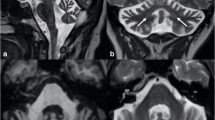Abstract
MRI makes it possible to study the in vivo brain and spinal cord morphology of patients with hereditary ataxia. We performed T1-and T2-weighted studies in eleven patients with Friedreich's disease (FD), five with “late onset” FD and ten with early onset cerebellar ataxia with retained tendon reflexes (EOCA). Cervical cord atrophy was constant in FD and “late onset” FD and often associated with atrophy of the cerebellum and of the brainstem; T2-weighted studies showed posterior column degeneration in the cervical cord. The most frequent finding in EOCA was cerebellar atrophy, pure or associated with cervical cord or brainstem atrophy; the cerebellar atrophy was marked in a few cases and was related to disease duration.
Sommario
La Risonanza Magnetica permette lo studio morfologico “in vivo” dell'encefalo e del midollo spinale nei pazienti con atassia ereditaria. Noi abbiamo eseguito uno studio con immagini T1- e T2-pesate in 11 pazienti con Malattia di Freidreich (MF), 5 con MF ad esordio tardivo e 10 con atassia cerebellare ad esordio precoce con conservazione dei riflessi osteotendinei (Early Onset Cerebellar Ataxia with retained tendon reflexes, EOCA).
L'atrofia del midollo cervicale era costante in MF ed MF ad esordio tardivo, spesso in associazione con atrofia cerebellare e del tronco. Le immagini T2-pesate mostravano degenerazione dei cordoni posteriori nel midollo cervicale.
In EOCA il reperto più frequente era l'atrofia cerebellare, pura od in associazione con atrofia del midollo cervicale o del tronco. L'atrofia cerebellare in EOCA era marcata in pochi casi ed era correlata con la durata di malattia.
Similar content being viewed by others
References
Bradac G.B., Riva A., Mortara P., Orsi L., Riccio A.:Primary progressive cerebellar ataxia. Neuroradiology, 31: 16–18, 1989.
Chamberlain S., Shaw J., Rowland A. et al.:Mapping of mutation causing Friedreich's ataxia to human chromosome 9. Nature, 334: 248–250, 1988.
De Michele G., Filla A., Cavalcanti F., et al.:Late onset Friedreich's disease: clinical features and mapping of mutation to FRDA locus. J. Neurol. Neurosurg. Psychiatry, 57: 977–979, 1994.
Fickler A.:Klinische und pathologisch-anatomische Beiträge zu den Erkrankungen des Kleinhirns. Deut. Zeit. Nervenheikunde 41: 306–375, 1911.
Filla A., De Michele G., Caruso G., Marconi R., Campanella G.:Genetic data and natural history of Friedreich's disease: a study of 80 Italian patients. J. Neurol., 237: 345–351, 1990.
Filla A., De Michele G., Cavalcanti F. et al.:Clinical and genetic heterogeneity in early onset cerebellar ataxia with retained tendon reflexes. J. Neurol. Neurosurg. Psychiatry, 53: 667–670, 1990.
Fraser D.:Defect of the cerebellum occurring in a brother and sister. Glasgow Med. J. 13: 199–210, 1880.
Greenfield J.G.:The spinocerebellar degenerations. Oxford: Blackwell Scientific Publications, 21–31, 1954.
Harding A.E.:Classification of the hereditary ataxias and paraplegias. Lancet, i: 1151–1155, 1983.
Mascalchi M., Salvi F., Piacentini S., Bartolozzi C.:Friedreich ataxia. MR findings involving the cervical portion of the spinal cord. Am. J. Roentgenol. 163: 187–191, 1994.
Nonne M.:Über eine eigenthümliche familiäre Erkrankungsform des Zentralnervensystem. Arch. Psychiatr. Nervenkr. 22: 283–316, 1891.
Oppenheimer D.R.:Brain lesions in Friedreich's ataxia. Can. J. Neurol., Sci., 6: 173–176, 1979.
Savoiardo M., Strada L., Girotti F. et al.:Olivopontocerebellar atrophy: MR diagnosis and relationship to multisystem atrophy. Radiology, 174: 693–696, 1990.
Wessel K., Schroth G., Wiener H.C., Müller-Forell W., Dichgans J.:Significance of MRI-confirmed atrophy of the cranial spinal cord in Friedreich's ataxia. Eur. Arch. Psychiatry Neurol. Sci., 238: 225–230, 1988.
Wüllner U., Klockgether T., Petersen D., Naegele T., Dichgans J.:Magnetic resonance imaging in hereditary and idiopathic ataxia. Neurology, 43: 318–325, 1993.
Author information
Authors and Affiliations
Additional information
This study was partially supported by the CNR (Grant 91.04180) and the Ministry of Health.
Rights and permissions
About this article
Cite this article
De Michele, G., Di Salle, F., Filla, A. et al. Magnetic resonance imaging in “typical” and “late onset” Friedreich's disease and early onset cerebellar ataxia with retained tendon reflexes. Ital J Neuro Sci 16, 303–308 (1995). https://doi.org/10.1007/BF02249105
Received:
Accepted:
Issue Date:
DOI: https://doi.org/10.1007/BF02249105




